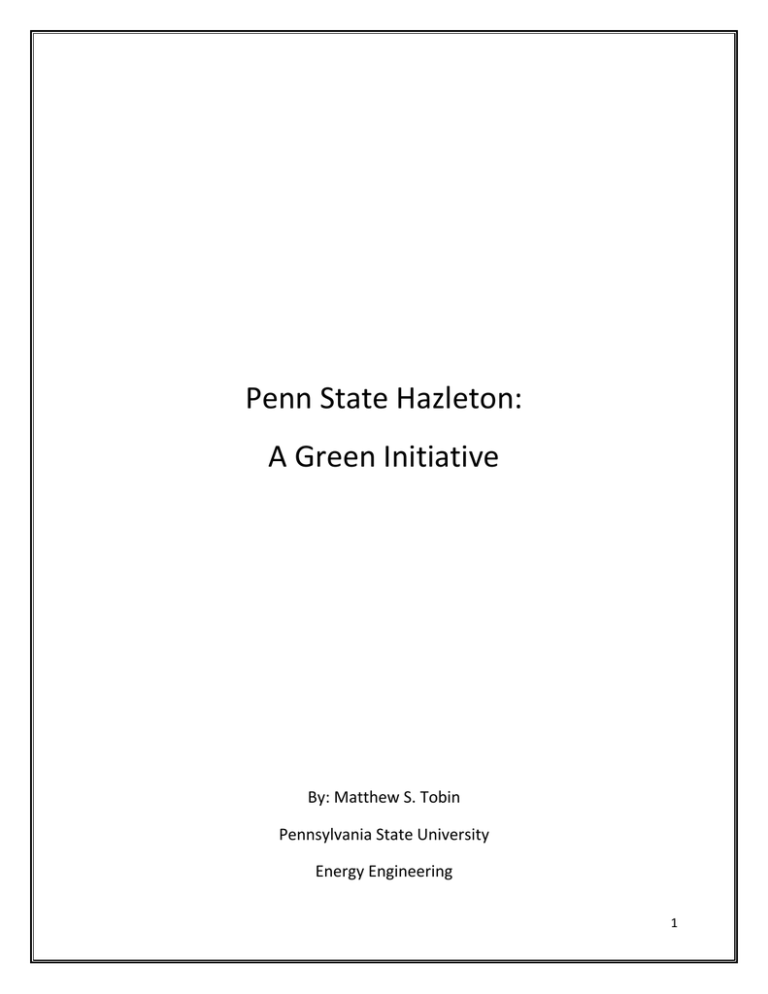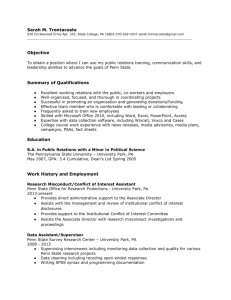File
advertisement

Penn State Hazleton: A Green Initiative By: Matthew S. Tobin Pennsylvania State University Energy Engineering 1 To: Penn State Hazleton Administrators From: Matthew Tobin, Energy Engineering major at Penn State Hazleton Subject: Making PSU Hazleton a cleaner, greener environment. As an energy engineering student, I constantly ask myself how I can make the world a better place. The Penn State Hazleton campus has been in service for decades. Unfortunately, through the time many of the campus buildings power and heating systems have become outdated and worn out. With rising costs of energy, demand for cleaner environment, and massive university budget cuts, it is time for Penn State to invest in alternative energy technology. Therefore, I propose to the Penn State Hazleton administration to invest in ‘green’ technology. By raising awareness and investing in various new systems, the campus will most certainly save on costs on energy; as well as contributing to a cleaner environment. This report explains in detail the problem that Penn State Hazleton faces, and various solutions to the problem. Out of the many solutions that I will cover, I will elaborate on the one that I believe to be the best investment in Hazleton’s time, energy, and money. Very Respectfully, Matthew S. Tobin Energy Engineering Major Pennsylvania State University 2 Table of Contents Cover Letter Page 2 Contents Page 3 Abstract Page 4 Introduction Page 5 Recommendation Problem Page 7 Solutions Page 8 My Final Recommendation Page 11 Sources Page 13 3 Abstract Penn State Hazleton is one of the leading Pennsylvania State University campuses for alternative energy education. Recently, the Hazleton campus became nationally recognized for being one of few campuses to offer a bachelor’s degree on alternative energy. However, the costs of attending Pennsylvania Universities are skyrocketing due to recent budget cuts. Therefore, funding for various programs such as these are going to be tough in the near future. With these rising costs, the university needs to start saving money. Every year Penn State University spends thousands of dollars on energy; which mainly includes electricity, heat, and water supply. Penn State Hazleton has two solutions to this problem. One solution would be to keep the campus as it stands, with no intervention. In other words, no changes will be made to the energy systems and Hazleton will continue to run off outdated systems, and continue to spend an excess amount of money on energy where it can be ill-afforded. The second solution would be to invest in renewable energy. This, I believe, is the best solution. With the numerous advances in modern-day renewable energy sources, they have become more available and efficient as ever. By using solar panels, windmills, or geothermal heating systems, Penn State Hazleton could potentially save thousands of dollars on energy costs. However, Hazleton will not save near as much money if it does not raise awareness and educate the students and staff on how to save energy. It sounds like a pointless gesture, but the money saved by simply turning off lights, computers, lowering the heat, or any simple task such similar to these can also save on energy while decreasing the electric bills. With the rising costs of Pennsylvania electricity, the decrease of Penn State funding, and the demand for clean energy, it would be in Hazleton’s best interest to invest the time and money in this solution. 4 Introduction In recent months, the United States government made waves in the Pennsylvania higher education system by approving a bill that would suspend funding to nearly every college and university in Pennsylvania. According to Penn State resources, “The budget cuts Penn State's appropriation by 52.4 percent, a devastating reduction of $182 million dollars.” The 182 million dollars that were reduced not only affect University Park campus, but every one of Penn State’s branch campuses will also be affected. On top of that, Pennsylvania electric providers are slamming residents with nearly a 30% increase on their bills due to rising costs. So what can Penn State Hazleton do? Well, we can start by setting an example for the rest of the Pennsylvania State University campuses. By investing in alternative energy, dramatically boosting energy awareness to each student on campus, we can ultimately save thousands of dollars on energy costs. As you can see here in graphs A, B, and C, the difference between energy usage in the summer months and the winter months is immense. A. 5 B. C. 6 In the more recent years, electricity, gas, and energy consumption has decreased in usage. However, not enough change has been introduced so far. Therefore, the point of my recommendation report is to describe to the administrators a few ways to continue the decrease in energy usage; through alternative energy, and raise of awareness. Recommendation The Problem: Penn State Hazleton has been operating for nearly 65 years. Many things have changed in that time; the exponential increase in energy costs, the demand for renewable energy, and ultimately a cleaner environment. The problem is that Penn State Hazleton has little invested in alternative energy, as well as time invested in raising ‘green environment’ awareness to campus students. Also, a few of the buildings across campus are using outdated systems which draw a lot of energy, and waste a lot of it at the same time. For example, I have found from personal experience that it is likely that the students themselves are primarily to blame for the annual increase in energy costs. This is due to lack of awareness and responsibility of the majority of students across campus. However, the lack of updated systems and inefficient buildings are also a cause of high energy costs. In conclusion, there are a few solutions that can solve these problems- some being more complicated than others, but all are very effective. 7 Solutions: President Obama recently made a visit to Penn State University, where he proclaimed that he and the US Gov’t backed the use and expansion of alternative energy through the ‘Better Buildings Initiative.’ This is plan that he unveiled to improve energy efficiency of commercial building space in the U.S. by 20 percent over the next nine years. With this concept in mind, there are many solutions to the problems Penn State Hazleton faces that are worth investing in. There are multiple branches of renewable energy sources which are known as: solar, wind, geothermal, and hydroelectric power. There are others- but are still in development and not within practical use at the time. One of the useful sources of alternative energy is the sun. This type of energy is derived from the sun’s light and heat. This type of energy is generally gathered through solar panels which can be easily placed on building rooftops or other structures. Even though solar panel technology can be costly due to installation and semiannual maintenance, they provide a constant source of energy. However, the level of output may vary, especially in the North-East Pennsylvania area where weather and cloud cover can Solar panels, such as these shown here, can be easily integrated into a buildings heating and electrical systems. be very unpredictable. 8 The second option for Penn State Hazleton is to use the power of wind. To harness this energy source, it involves the use of wind generators. Wind generators are one of the cheapest, but most reliable renewable energy source. According to altenergy.org, “people are realizing that wind power "is one of the most promising new energy sources" that can serve as an alternative to fossil fuel-generated electricity. As of 1999, global wind energy capacity topped 10,000 megawatts, which is approximately 16 billion kilowatt-hours of electricity. That's enough to serve over 5 cities These wind generators shown here are massive; the rotor diameter is likely to be around 100m. Wind generators are usually found in ‘wind farms’, where dozens of windmills potentially lie. the size of Miami.”(American Wind Energy Association) So, it is obvious that wind generators are a useful energy source. If one were to travel a few miles north to Scranton, they will likely see a wind farm in that area. Due to the jet-stream and atmospheric activity, North-Eastern PA is a productive area for windturbine power generation; especially on top of the mountains where the majority of NorthEastern PA lies. Since Hazleton is at a high elevation, wind turbines would be an excellent renewable energy source. Unfortunately, an airport lies close to Hazleton, and FAA regulations make it that these wind-turbines cannot be placed on campus. However, there are alternatives to the large wind-turbines. These smaller 9 turbines, as shown in the picture above, are only a few feet in diameter and can could easily be placed nearly anywhere on campus. These smaller generators can be used to power 12 volt systems, or any smaller electronic device. A few of these smaller wind-turbines can easily power computers, lights, and other electronic devices. With wind blowing quite often in Hazleton, these smaller turbines would be an excellent alternative energy solution. I believe that the final useful alternative energy option for Hazleton is geothermal energy. Geothermal energy is energy generated from heat from the Earth’s core, and since the core is always hot, it will continuously produce energy. The only issue with geothermal energy is the installation. Research needs to be done to examine the Geographic’s of the region to determine if it is suitable for geothermal energy production. If geothermal energy production is possible, then a system installation can be required which can affect cosmetics of a property, but only for a few days. For Penn State Hazleton, I would recommend this being done over the summer This geyser is an example of geothermal energy. Harnessing this energy gives us the ability to heat/cool water and air systems. when school is out. If geothermal systems were to be installed, it would be most useful to supply hot/cold water and air to student dorms and classroom buildings. Since the majority of heated water is used for dorm showers, using geothermal energy to heat this water would 10 dramatically save on heating costs. Therefore, if Penn State Hazleton region checks-out for geothermal energy, it would be a great solution. My Final Recommendation: After extensive research on numerous forms of alternative energy, I have come to the conclusion that a combination of all alternative energy sources would be most effective; along with raising awareness to students and staff on campus. Even though raising awareness sounds simple and pointless, the effects it could have on energy costs would be dramatic. According to energy.opp.psu.edu, “Approximately 40% of Penn State’s power usage is under discretionary control of the building occupants. Each student can make important contributions to energy conservation. If each person at University Park saved a penny’s worth of electricity daily, they would save Penn State almost $200,000 annually and prevent the release of over 11 million lbs. of carbon dioxide emissions each year. These are things you can do to save one penny: turn off your computer and monitor for one hour, turn off a standard desk lamp for three hours, three and a half hours of operating that compact fluorescent light bulb instead of a incandescent bulb, reset the temperature setting on your micro fridge one position higher which will save several penny's a day. Energy conservation efforts at other universities have reduced energy consumption by 40%, leading to millions of dollars saved annually. Energy consumption at Penn State has increased every year over the past 30 years.” Understandably, we are not University Park, and we do not have nearly as many students as U-Park. However, the statistics still relate, students account for the majority of energy consumption. 11 So, if every student and faculty member took the responsibility to save on energy, it could still save Hazleton thousands of dollars on energy costs. I recommend that the money Penn State Hazleton saves on raising awareness goes to a fund to install various sources of renewable energy on campus. I believe that the best way to save on costs and harmful emissions would be to use various renewable energy sources all working in concert. Using solar, wind and geothermal power will undoubtedly save Penn State Hazleton thousands of dollars on energy costs, as well as showing the community our devotion to a better environment. Since Penn State Hazleton is the first campus to introduce an “Alternative Energy Engineering” degree across all the Penn State campuses, I believe investing the time in raising awareness and investing money into renewable energy would be an excellent buffer for that degree. If the Hazleton were to take on this “Green Initiative”, it will show other campuses how much can be gained from saving on energy costs. From this point, other campuses would be wise in following in Hazleton’s footsteps, which could save millions of dollars in energy costs. 12 Sources: "Alternative Energy Solutions for the 21st Century." Alternative Energy. 15 Apr. 2011. <http://www.altenergy.org/>. “American Wind Energy Association.” 2006. 15 Apr. 2011. <http://awea.org/>. "Devastating Appropriation Cut Advanced for Penn State." Penn State LIVE. 15 Apr. 2011. <http://live.psu.edu/story/51840>. "EMS Energy Institute." Pennsylvania State University. 2010. 5 Apr. 2011. <http://www.energy.psu.edu>. "Energy." PSU OPP Energy. 1 Jan. 2005. 1 Apr. 2011. <http://energy.opp.psu.edu/>. "Solar Panels." Wikipedia. 9 Apr. 2011. 10 Apr. 2011. <http://en.wikipedia.org/wiki/Solar_panel>. 13





